2022 Harley-Davidson Road Glide ST and Street Glide ST - First Ride

Harley's best sellers get a performance twist.
Harley-Davidson has the fortunate position to stand atop the perch that is its popularity and loyal following to see where its customers take their motorcycles. Yes, the folks at Harley hear all the time about the different places their motorcycles have taken them. But Harley designers and engineers also have the advantage of reading the pulse of their customer base by seeing what these people decide to do to customize and modify their bikes. Need I remind anyone of the unfortunate custom chopper craze of not too long ago…?
2022 Harley-Davidson Road Glide ST and Street Glide ST
Editor Score: 82%
| Engine | 18.5/20 | Suspension | 12/15 | Transmission | 7/10 |
| Brakes | 7.5/10 | Instruments | 4/5 | Ergonomics | 8.5/10 |
| Appearance | 9.5/10 | Desirability | 9/10 | Value | 6/10 |
+ Highs
- Understated good looks
- That 117ci engine is a torque monster
- More suspension travel is a good thing
– Sighs
- Traction control is too intrusive
- Rear springs are too stiff for my scrawny butt
- Not making the preload adjuster knob easier to reach seems like an oversight
Brad Richards, Harley’s VP of Design, certainly doesn’t need any reminding. The way he sees it, Harley-Davidson creates the motorcycle and the customer base will customize it to their aesthetic. If that aesthetic catches on, like the custom chopper scene did, the folks at Harley will inevitably take note and might even incorporate it into the next design loop. It happens every generation. “It’s a conversation,” says Richards, “and the language is the motorcycle.”
This latest generation is the product of the chopper craze, and as each generation tends to do, they scoff at their predecessors and move in a different direction. The trend nowadays is the shift away from raked-out forks, giant wheels, glitter paint, and an all-around terrible riding experience, to a move towards functional, performance-oriented cruisers and baggers. When enough of these performance baggers warranted a need to race them – and MotoAmerica obliged with the King of the Baggers series – Harley-Davidson took notice.
The 2022 Road Glide ST and Street Glide ST are the result of this performance trend that started at the customer level. Harley-Davidson even went so far as to build its own King of the Baggers racer based on the 2021 Road Glide, which Kyle Wyman won the championship with (and I got to ride! Stay tuned for my review on that in a future story). That bike had an influence on the 2022 ST line, including the Road Glide and Street Glide.
Defining A Performance Bagger
The term “Performance Bagger” is an oxymoron to many, but Richards and his design team took it as inspiration for the aesthetic of the new Glides – and if there’s one thing Harley-Davidson does better than the rest, it’s nailing an aesthetic.
As you look at the Road and Street Glides, their signature fairings (whether fork- or frame-mounted) and overall shape look familiar. But the flashy chrome and pearl paint are gone. In their place are the only two color options available: Vivid Black and Gunship Gray. As the names imply, there’s nothing fancy about these colors. No pearl undertones. No two-tone colorways. None of that. These colors are all business. But in typical Harley style, both colors land a striking appearance under the sun. Harley does know a thing or two about paint, after all.
The visual appearance is accented by most of the ancillary components being blacked out. The only bits of chrome you’ll see are the pushrod tubes, tappet covers, and machined cylinder fins. Instead of the chrome we’re used to seeing in the past, the new accent color for 2022 is bronze. The cool multi-spoke wheels, lower rocker box, timing cover medallion, and the classic Harley-Davidson script across the gas tank are all in bronze. To my eyes, the bronze accents really bring home the Glide’s overall aesthetic – especially the wheels which look like they have a Cerakote finish applied to them. Very cool.
But there’s more to the new Glide ST’s appearance than just paint and bronze. According to Richards, his team focused on making the bikes look “visually lighter.” Doing so meant trimming the fat off both of these big bikes. Visually, anyway. They say wearing black makes you look slimmer, and the same applies here. Blacking out most of the Glide’s components and focusing the attention on anything with paint or bronze does visually slim down the bike, but beyond redirecting the viewer’s attention, the Glides also sport a shortened front fender that wraps around the tire closely, standard-length saddlebags in place of the extended bags on Special models, a low-profile engine guard, and a solo seat (and the accompanying removal of passenger pegs) all serve to tighten up the two Glides. The standard saddlebags also allow a little more lean angle before hard parts touch down, and give room for more exhaust options, too.
The Mechanical Goods
All this and we haven’t even begun talking about the heart of the beast – the Milwaukee-Eight 117 air/oil-cooled V-Twin. For the first time, Harley is offering its biggest production engine in a non-CVO model (the 131ci crate engine not included) to show it’s serious about the performance bend these bikes are meant to have. To be clear, this is for the ST versions of the Road Glide, Street Glide, Low Rider S and ST. The engines in the standard versions are unchanged.
Beyond the bigger engine, the ST Glides come with a few more goodies: a higher-performance camshaft, the “Heavy Breather” forward-facing intake, and a high-performance, 50-state legal exhaust. Harley says the sum total comes out to 117 cubic inches (or 1,923 cubic centimeters for our metric friends) and a 10.2:1 compression ratio, making 106 horsepower and a meaty 127 lb-ft of torque – that’s nearly 7% more torque than the 114ci in the previous Street Glide Special.
Lending to the ST’s more sporty vibe, the rear suspension not only includes a remote preload adjuster, but there’s now – get this – three whole inches of suspension travel! It may not seem like much, but for the longest time we’ve complained about past Harleys having such ridiculously little rear suspension travel, all in the name of low seat heights. With these new shocks, it’s still really easy for the average adult to throw a leg over, but now, they have the benefit of a better ride. At least that’s the theory (more on that later).
Brembo provides the stopping power for the STs with its linked braking system. ABS is standard and operates independently on either wheel. For a little extra piece of mind, Harley offers the optional Cornering Rider Safety Enhancements package. Borrowing from the sportbike world, this package features a six-axis IMU to read the bike’s position. The actual safety features include:
- Cornering ABS
- Cornering linked brakes
- Cornering traction control (with modes)
- Drag torque slip control
- Vehicle hold control
- Tire pressure monitoring
Rounding out the Road Glide and Street Glide STs is Harley’s Boom! Box GTS Infotainment system, which is an evolution of the past systems. A big color touchscreen display greets you no matter if you choose the Street Glide or Road Glide, and it’s compatible with both Apple CarPlay or Android Auto. Two fairing-mounted speakers blast the tunes to your face (and adjust their intensity depending on road speed), as a hidden antenna keeps the look of the bike clean while getting a radio signal for you to blast your awful music to the world.
If these two new ST models are catching your attention, but you’re yearning for even more performance, that’s when the Screamin’ Eagle catalog becomes your best friend. Here you’ll find even more go-fast (or look cool) goodies, topped by the 131ci Milwaukee Eight crate engine with ported cylinder heads, 1mm larger valves, a high-lift camshaft, high-compression forged pistons, different cam bearings, a larger throttle body, and higher-flow injectors to pump out 131 lb-ft of torque to the rear wheel. Then there’s the Screamin’ Eagle exhaust to free up a little more power, too.
And to show just how much influence racing baggers has had on Harley, the Screamin’ Eagle catalog also includes Öhlins FGR 250 superbike forks and remote reservoir shocks. Both were built specifically for Harley-Davidson, with lengths, spring rates, valving, etc. designed for this application. These are not just repurposed pieces from other bikes with different internals. How’s that for a performance bagger?
Riding Impressions
Readers who know me probably find it strange to see my byline on a Harley review. Being the sportbike guy and all, you might think baggers would bore me. Maybe that’s what makes me the perfect candidate on the MO staff to give the new Street Glide and Road Glide STs a try. That and I occasionally do like to ride cruisers, don’tchaknow. But with my background, I’m bound to be a little more critical of a performance-oriented bagger.
Right off the bat, however, I have to admit that I really like the dark-and-bronze colorway of both bikes – the Road Glide especially. The frame-mounted fairing is more my style, and seeing one in your rearview mirror is about the closest you can get on two wheels to being followed by a Peterbilt. I think that (and the marginally better wind protection) is pretty cool in my book.
Cruisers, of course, are all about the freedom of the open road. Riding both the Street and Road Glide STs along the open expanses in and around Wilcox, Arizona, the message was driven home loud and clear. Call it drinking the Kool-Aid if you want, but there’s something relaxing about sitting on either Glide and watching the miles go by. Despite the bikes’ heft, I didn’t have to strain to reach the bars, nor were my feet stretched too far forward to reach the controls. Everything fell into place.
Being the performance-oriented guy that I’ve typecast myself as, getting my jollies off was pretty easy with all that torque underneath me. Whenever I’d command it, that big 117ci M8 engine was happy to let loose and shove me back in my seat – when I had traction control turned off.
Herein lies my first qualm. The TC is overly sensitive. Despite being on dry pavement without any lean angle, aggressive acceleration is enough to trigger the electronic nannies. Following a hard launch and a clutchless upshift, opening the throttle again is met with a huge delay and the TC light on the dash flashing in your face. After a half-second or so, the power you originally requested starts to come on line. This happens in the first three gears. Fortunately you can hold down the TC button for a second or two and deactivate the system. With TC turned off, the hooligan fun can begin. Yes, this means you can get your rocks off doing rolling burnouts, but you can also accelerate with gusto in the first three gears and have the power delivery to the ground match the amount you’re twisting with your wrist.
Cruising along the highways in Arizona, both bikes predictably provide a very similar riding experience – not surprising considering the main difference is where the fairings are mounted. But not only do I find the looks of the Road Glide more appealing, I also gravitated to its wind protection. Both fairings block plenty of wind from hitting my chest, but for my 5-foot, 8-inch frame, the Road Glide’s frame-mounted fairing moved more wind over my head whereas the Street Glide’s fork-mounted fairing seemed to direct more air towards it. In the Street’s defense, the position of the infotainment screen and gauges on the fork-mounted fairing were more within my line of sight. You need to cock your head down a smidge on the Road Glide to look at that stuff.
Now, Wilcox, Arizona isn’t known for its twists and turns, but when Harley says this is a performance bagger with better ground clearance and more rear suspension travel, you can’t help but look for anything resembling a corner to find out if those claims are true. We already know the two Glides will scoot you (quickly) down the open road in relative comfort, but how do they handle? I know this isn’t saying much, but as you can see in some of the pictures here, I’m not dragging the floorboards. Sure I could have, but for the given speed to make the corner it really wasn’t necessary. To me, that in itself is a step in the right direction.
Here’s where we get to my second and third qualms with the Glide STs, though. Adding more suspension travel to the rear is a great thing, no doubt. However, the benefit of added travel is to use up that stroke to absorb bumps in the road and give the rider a plusher ride. That’s not happening in this case. Maybe it’s just my 150 pounds not exerting enough static weight on the springs, but the spring rate feels a little too stiff for my tastes, as I could feel every little bump or jolt in the road through my feet, legs, and butt. Do Harley riders like this kind of thing? Does it get them as close to a hardtail without the full commitment? I don’t know. Could I have adjusted the preload to help? Sure, but the remote adjuster knob requires you pull off the left saddlebag to access it. Granted, Harley makes it fairly easy to pull the bag off, but simply making the remote adjuster a little longer and easier to get to could have also solved that problem.
Still As American As Apple Pie
Maybe I’m being too critical, but when a model is billed as having a performance slant to it, the doors have opened to a little more criticism. Nonetheless, don’t let that take away from the experience of the whole thing – that is cruising in relative comfort with a little muscle to back it up. Throw some clothes and a sandwich in the bags and you can get away for a nice weekend escape, too. Should the road present you with a few twists and turns, the two Glide STs are now better equipped to get you through them. Hell, if you’re heavier than I am then my perceived complaints may not be a problem at all for you.
Harley-Davidson has caught flack in recent years for pandering to an aging customer base instead of attracting new blood. With bikes like the Pan America and Sportster S (and more yet to come), Harley is showing us it knows how to pivot and build motorcycles many of us, myself included, never expected it would. With the Street Glide and Road Glide STs, Harley is reminding us that it’s not done refining and perfecting its bread and butter.
In Gear

Helmet: Scorpion EXO-R1 Air Carbon
- Jacket: Alpinestars Oscar Bomber
- Airbag: Alpinestars Tech-Air 5
- Gloves: Alpinestars Equinox OutDry
Boots: Alpinestars Oscar Rayburn
Specifications | 2022 Harley-Davidson Road Glide ST | 2022 Harley-Davidson Street Glide ST |
|---|---|---|
| MSRP | Starts at $29,999 | Starts at $29,999 |
| Engine | Milwaukee-Eight 117 | |
| Valves | Pushrod-operated, overhead valves with hydraulic, self-adjusting lifters; four valves per cylinder | |
| Bore | 4.075 in. (103.5 mm) | |
| Stroke | 4.5 in. (114.3 mm) | |
| Displacement | 117 cu in (1,923 cc) | |
| Compression Ratio | 10.2:1 | |
| Horsepower | 106 hp at 4750 rpm (claimed) | |
| Torque | 127 lb-ft. at 3750 rpm (claimed) | |
| Fuel System | Electronic Sequential Port Fuel Injection (ESPFI) | |
| Air Cleaner | Paper, washable | |
| Exhaust | Dual, with crossover | |
| Lubrication System | Pressurized, dry-sump with oil cooler | |
| Primary Drive | Chain, 34/46 ratio | |
| Final Drive | Belt, 32/68 ratio | |
| Clutch | Pressurized, dry-sump with oil cooler | |
| Transmission | 6-Speed Cruise Drive | |
| Frame | Mild steel; tubular frame; two-piece stamped and welded backbone; cast and forged junctions; twin downtubes; bolt-on rear frame with forged fender supports; MIG welded. | |
| Swingarm | Mild steel; two-piece drawn and welded section; forged junctions; MIG welded. | |
| Front Fork | 49mm Dual Bending Valve. 4.6 inches of travel. | |
| Rear Shocks | Premium standard height hand-adjustable rear suspension. 3.0 inches of travel. | |
| Front Wheel | Bronze Prodigy | |
| Rear Wheel | Bronze Prodigy | |
| Front Tire | Dunlop Harley-Davidson Series, bias blackwall, 130/60B19 61H | |
| Rear Tire | Dunlop Harley-Davidson Series, bias blackwall, BW 180/55B18 80H | |
| Front Brake | 4-piston fixed front; dual 300 mm discs | |
| Rear Brake | 4-piston fixed; 300 mm disc | |
| ABS | Standard | |
| Lean Angle | 32° left and 31°right | |
| Fuel Economy | 41 mpg (5.7 l/100 km) (claimed) | |
| Lights (as per country regulation), Headlamp | LED 40-watt, 1,060 lumen low beam, 60-watt, 1560 lumen high beam. | |
| Lights (as per country regulation), Tail/Stop | 8W/28W | |
| Lights (as per country regulation), Front Signal Lights | 8W/28W | |
| Lights, Rear Turn Signals | 8W/28W | |
| Gauges | Gauges styled to complement each vehicle. Display features odometer, trip A, trip B, range to empty and gear indicator; and larger tell-tale indicators. | |
| Electric Power Outlet | Electric power accessory port in fairing | |
| GPS | Boom!™ Box GTS audio system with GPS and touchscreen | |
| Length | 94.7 in. (2,405 mm) | 94.5 in. (2,400 mm) |
| Overall Width | 37.6 in. (955 mm) | 37.8 in. (960 mm) |
| Overall Height | 52.2 in. (1,325 mm) | 53.1 in. (1,350 mm) |
| Seat Height | 28.1 in. (715 mm) | 28.0 in. (710 mm) |
| Ground Clearance | 5.5 in. (140 mm) | 5.3 in. (135 mm) |
| Fork Angle | 29.25° | |
| Rake | 26° | |
| Trail | 6.7 in. (170 mm) | |
| Wheelbase | 64 in. (1,625 mm) | |
| Fuel Capacity | 6 gal. (22.7 l), 1 gallon reserve | |
| Oil Capacity (w/filter) | 5.2 qt. (4.9 l) | |
| Curb Weight | 842 lb. (382 kg), claimed | 814 lb. (369 kg), claimed |
| Warranty | 24 months (unlimited mileage) | |
| Service Interval | First 1,000 miles (1,600 km), every 5,000 miles (8,000 km) thereafter | |
We are committed to finding, researching, and recommending the best products. We earn commissions from purchases you make using the retail links in our product reviews. Learn more about how this works.
Become a Motorcycle.com insider. Get the latest motorcycle news first by subscribing to our newsletter here.

Troy's been riding motorcycles and writing about them since 2006, getting his start at Rider Magazine. From there, he moved to Sport Rider Magazine before finally landing at Motorcycle.com in 2011. A lifelong gearhead who didn't fully immerse himself in motorcycles until his teenage years, Troy's interests have always been in technology, performance, and going fast. Naturally, racing was the perfect avenue to combine all three. Troy has been racing nearly as long as he's been riding and has competed at the AMA national level. He's also won multiple club races throughout the country, culminating in a Utah Sport Bike Association championship in 2011. He has been invited as a guest instructor for the Yamaha Champions Riding School, and when he's not out riding, he's either wrenching on bikes or watching MotoGP.
More by Troy Siahaan



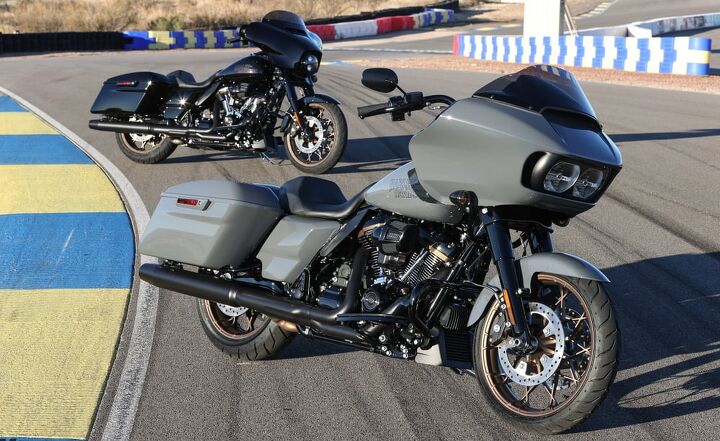
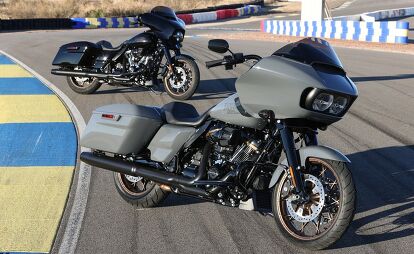




































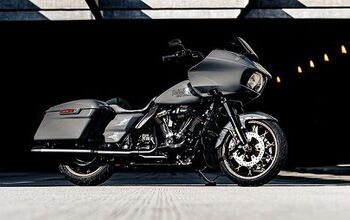





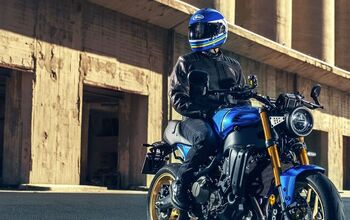










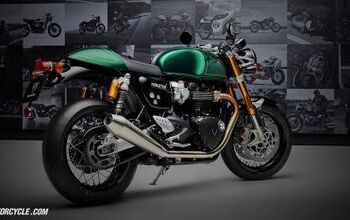
Comments
Join the conversation
All my bikes but together didn’t cost a total of $30,000 and I’ve been riding since the 70s. I tend to keep my bikes for a long time. It’s not that I can’t afford a $30,000 motorcycle, I just have my standards and spending $30,000 on a bike is out of the question.
Troy might be the only man who weighs 150 pounds to ever ride a modern Harley. Those springs are meant for the average HD customer base, which checks in at over 200, and to have the Ole Lady on the back too. Kudos are in order if the spring rate is correct for all that.